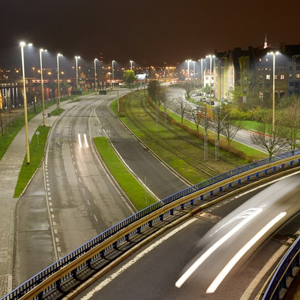More cities are making the switch to smarter lighting solutions for their streets. Solar powered lighting, internet connected LED lighting and remote monitoring/controlling are just some of the latest features that can go into street lighting. But cities are not upgrading because of the novelty factor, these technologies have an important number of benefits that can end up saving cities millions.
Recently Las Vegas set in motion a green upgrade on their streets, upgrading a number of its street light fixtures to utilise solar and pedestrian power by using solar panels and kinetic pads to harvest power in a world first using this type of technology. The EnGoPLANET Street Lights which are being installed can also be upgraded to measure air quality, temperature, humidity, and water, as video surveillance cameras monitor and analyse traffic. These lights can also act as built-in Wi-Fi hotspots and charging stations for passing foot traffic.
In Madrid, Buenos Aires and Los Angeles global lighting leader Phillps has rolled out its internet-connected LED street lighting. These smart lights can now be connected in such a way that they can be monitored and controlled remotely, thanks to Philips partnership with Vodafone to connect the lights wirelessly via M2M SIM cards. This allows the street lights to be connected to Philips’ CityTouch street lighting management system, making it possible for the brightness of streetlights to be adjusted in real time and for lights to be switched on and off at specific times from a web browser. Lights can also be monitored to see when maintenance is required or when bulbs need replacing.
London has begun the installation of Monopoles, a new “zero-emission streetlight” from tech company Scotia, on a small scale. The energy these lights generate via solar panels can then be stored in a battery and used during the night to power the lamps. What’s more, these lights can create a surplus of energy that can be directed back into the national grid, cutting energy costs and potentially saving millions. These lights, which have already run pilot programs in Copenhagen, Abu Dhabi and Riyadh, are designed to run in the bleakest of conditions and can be installed with no machinery and minimal manpower.
Importantly, it’s not just cities that can potentially benefit from these fixtures. Small towns, rural areas and areas with no power grid or little access to power could use these fixtures to power their towns, their farms, and their park facilities.
What do all these projects all have in common?
- An increase in energy efficiency
- Significant savings on energy
- The desire to maximise the full potential of the humble streetlight
Most significantly, the aim these projects work towards – making a dent in the estimated 100 million tons of CO2 released every year to power the 300 million streetlights scattered around the globe.
Traditional street light poles have, until now, been stationary structures with little to give back. Now technology has changed the name of the game for a more efficient and sustainable tomorrow.
Top to bottom, left to right: Las Vegas Solar street lights, EnGoPLANET Street Lights, Phillips street LED lighting, Phillips’ CityTouch management system in action, Scotia Monopole streetlights at the Light + Building trade show in Frankfurt, Scotia Monopole™ Cell, Scotia Monopole™ Grid, Scotia Monopole™ Connect
|
|
About ODS Contributor
View all posts by this author » |

















